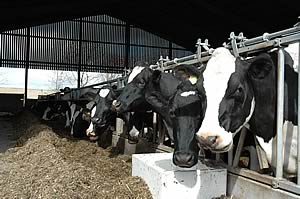 |
|||||||||
|
|||||||||||||||||||
|
|
Feeding a Moist Ration to Dairy Cows May Be a False Economy Dairy farmers can increase milk production simply by challenging the current trend of using moist feeds in their cows’ diet.
That is according to Steve Brown, ruminant feeds product manager for Wynnstay, who believes that there is evidence to suggest that dairy farmers should question both the nutritional and financial wisdom of including too much moist feed in the diet of highly productive dairy cows. “The current economics of dairy farming mean that it is all too easy for farm and herd managers to be won over by the price per tonne of moist feeds. But it is essential to remember that there are no calories in water,” Mr Brown remarks. In order to assess the real cost, Mr Brown advises farmers to always convert the price per tonne to a dry matter price. “An £80/tonne wet feed with a 35% dry matter content, energy content of 14MJ/kg DM, crude protein of 350g/kg DM (35%) and oil content of 100g/kg DM (10%) seems at first sight to be good value,” Mr Brown explains. “However, on an as fed basis each kilo will only actually deliver 4.9MJ/kg of energy, 12.25% crude protein and 3.5% oil.” Therefore, in order for each cow to receive the quoted nutrient values, the cost per tonne must be divided by the dry matter content (e.g. £80 divided by 0.35). All of a sudden, the £80/tonne price tag rises to a considerably less attractive £228.57 per tonne of dry matter.” Evidence of the benefit of switching from a moist feed to a dry blend has been seen on a high yielding dairy herd in South Wales. “The herd was originally receiving 10kgs/head/day of a 50% dry matter moist feed as part of the daily ration,” Mr Brown explains. “When the herd was moved onto a Wynnstay dry blend with an equivalent nutrient specification, milk output increased within a week by 1.2 litres per cow across the entire herd.” The change in diet was achieved at a similar cost per tonne of dry matter, giving the equivalent of an extra £11,000 of milk per year for every 100 cows at a milk price of 25 pence per litre. The herd’s fertility status and milk quality also improved as a result of a less acidic rumen environment. “And with fewer feed lorries coming up the farm drive, there are additional time and administrative savings to be made,” Mr Brown states. “This isn’t a new theory by any means,” Mr Brown continues. “Professor Boutflower proved in the 1930s that animals should ‘drink water, not eat it’, when Cirencester Beauty of the Steadings Herd produced 58,300 litres of milk in five lactations from a high dry matter ration. That is equivalent to an average of 11,660 litres per lactation - a significant yield by any standards, especially when you consider that the cow in question wasn’t a pedigree Holstein.”
|
||||||||||||||||||

|
|
||||||||||||||||||
| home | agri-services | pedigree
pen | news | dairy | beef | machinery BPS | property | organisations | site map |
|||||||||||||||||||
